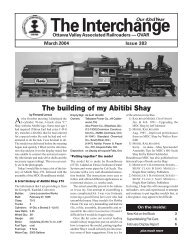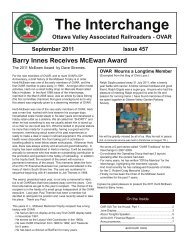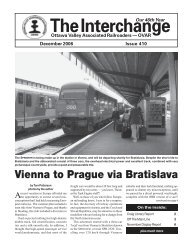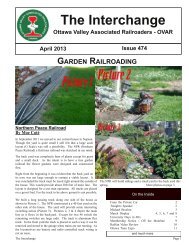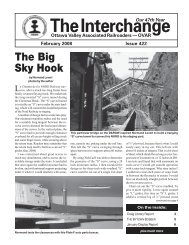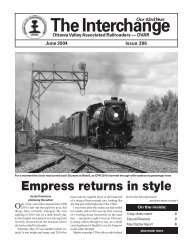The Interchange - Ottawa Valley Associated Railroaders
The Interchange - Ottawa Valley Associated Railroaders
The Interchange - Ottawa Valley Associated Railroaders
Create successful ePaper yourself
Turn your PDF publications into a flip-book with our unique Google optimized e-Paper software.
y Ian Cranstone<br />
photos by the author<br />
Those of us who were fortunate enough<br />
to be able to attend the GOLDEN RAILS<br />
conference in Winnipeg on the May long<br />
weekend got to experience a real treat: riding<br />
the rails of the Assiniboine <strong>Valley</strong> Railway.<br />
<strong>The</strong> <strong>Interchange</strong><br />
Our 43rd Year<br />
<strong>Ottawa</strong> <strong>Valley</strong> <strong>Associated</strong> <strong>Railroaders</strong> — OVAR<br />
June 2005 Issue 396<br />
GOLDEN RAILS conference at Winnipeg during the May long weekend featured a visit to Assiniboine <strong>Valley</strong> Railway as a kickoff<br />
event on the Friday evening. OVAR member Harry Hulvershorn (at far left) watches as excursion trains provide rides to conventioneers.<br />
Charleswood station building at rear functions as train shed/workshop, with two tracks embedded in concrete floor.<br />
Railroading on a grand scale:<br />
1 1 ⁄2" to the foot scale Assiniboine <strong>Valley</strong> provides a whole new view of model railroading<br />
Nestled on a five-acre lot sandwiched between<br />
the west side of Assiniboine Park and<br />
the Winnipeg district of Charleswood, this<br />
treasure is well-hidden from the road by a<br />
long driveway.<br />
Built to a scale of 11 ⁄2" to the foot (and a<br />
track gauge of 71 ⁄2"), three locomotives took<br />
...continued on page 4<br />
On the inside:<br />
Herb McEwan 2<br />
Turn That Locomotive 3<br />
May Display Report 6<br />
plus much more
HERB McEWAN (1902-1966)<br />
As the first OVAR member to pass on, Herb McEwan’s name lives on in the form of<br />
the annual award given in his memory. (photo courtesy of David McCurdy)<br />
1968 1 Joe Thomas<br />
1969 2 Bob Craig<br />
1970 3 Adrian French<br />
1971 4 G. “Toots” Eggert<br />
1972 5 Bill Williams Sr.<br />
1973 6 Doug MacKenzie<br />
1974 7 Tom Hood<br />
1975 8 Dave Knowles<br />
1976 9 Brian Ludlow<br />
1977 10 Reg Bilodeau<br />
1978 11 Jim Jarrett<br />
1979 12 Al Craig<br />
1980 13 Tony Chinery<br />
TIMETABLE<br />
Upcoming events of particular<br />
interest to OVAR members<br />
June 21: OTTAWA – Bytown Railway Society,<br />
Canada Science and Technology Museum,<br />
1867 St. Laurent Blvd. 7:30 p.m.<br />
Info:<br />
www.bytownrailwaysociety.ca<br />
July 15-17: SMITHS FALLS – Chocolate<br />
& Railway Festival, Smiths Falls Railway<br />
Museum, 90 William St. W., Info: Hugh<br />
Laing (613) 592-9402 or Frank Steele (613)<br />
378-1361<br />
www.magma.ca/~sfrm/event.htm<br />
August 13-14: GANANOQUE – Thousand<br />
Islands Model Railroad Show,<br />
Gananoque Recreation Centre, 600 King<br />
St., Sat. & Sun. 10 a.m.-4 p.m. Info: Bill<br />
Bowman (613) 382-7575, e-mail: timrailroaders@aol.com<br />
July 3-10: CINCINNATI – CINCINNATI<br />
LIMITED NMRA National Convention &<br />
National Train Show, Info:<br />
www.cl2005.com<br />
www.nationaltrainshow.org<br />
September 7: CORNWALL – Moccasin<br />
Model Railroad Club, Nativity Hall, 7:30<br />
p.m. Info: Chris Patrick, e-mail:<br />
cpatrick1@cogeco.ca<br />
Herb McEwan Car Recipients 1968-2005<br />
(Year/Car #/Recipient)<br />
1981 14 Odfried Wendler<br />
1982 15 Bill Scobie<br />
1983 16 Tony Mitchelson<br />
1984 17 Jim Simpson<br />
1985 18 Ross Peever<br />
1986 19 Omér Lavallée<br />
1987 20 Bill Erwin<br />
1988 21 Michel Boucher<br />
1989 22 Bruce Curry<br />
1990 23 David Stremes<br />
1991 24 Brian Earl<br />
1992 25 Dave Venables<br />
1993 26 Ron Shurtliffe<br />
Check out OVAR’s Web Site<br />
www.ovar.ca<br />
1994 27 Carl Swail<br />
1995 28 Ken Healy<br />
1996 29 Jim Nelson<br />
1997 30 Stew Waldron Sr.<br />
1998 31 David Steer<br />
1999 32 Marty Phillips<br />
2000 33 Steve Adamson<br />
2001 34 Angus Palmer<br />
2002 35 Mike Hamer<br />
2003 36 Peter Nesbitt<br />
2004 37 Earl Roberts<br />
2005 38<br />
2 <strong>The</strong> <strong>Interchange</strong>
Turn that<br />
locomotive<br />
SFV No. 162, just<br />
off train 515, is being<br />
turned on the<br />
turntable at Sorel<br />
by Colin J. Churcher<br />
photos by the author<br />
“<br />
Dispatcher, why is Sorel taking such a<br />
long time making up 518 today, he only<br />
has one car?”<br />
We are on Ken Healy’s St. Francis <strong>Valley</strong><br />
Railway and that is the yardmaster Drummondville<br />
getting on my case again. 518 is a<br />
local freight train with cars from Sorel to<br />
Drummondville. <strong>The</strong> train is ready but I<br />
have been waiting a couple of hours for the<br />
power — the unit off inbound 515 from<br />
Drummondville goes back on 518. What<br />
takes the additional time is that the unit has<br />
to be turned.<br />
Why is this? It will go just as well backwards<br />
as forwards. This particular unit is set<br />
up to run short hood forwards. <strong>The</strong> engineer<br />
faces forward and the controls are within<br />
easy reach. To run the train in the opposite<br />
direction means he has to crane backwards<br />
and his visibility is severely restricted. <strong>The</strong><br />
only thing to do is to turn the unit or to provide<br />
a second unit facing the opposite direction<br />
but 515 — 518 is normally a light<br />
working and management will not provide a<br />
before heading<br />
back to Drummondville.<br />
second unit. Some diesels, including some SFV No. 162 has been turned and is waiting at the head of train 518 on the yard lead,<br />
on Canadian National, are fitted out to run<br />
long hood forward and in this case it is diffi-<br />
ready to leave as soon as the Drummondville yardmaster can accept it.<br />
cult for the engineer to run such a unit on a couple of minutes. If we were lucky we the wye (triangle) rather than going on shed<br />
train with the short hood forward. <strong>The</strong> rea- would get the signal for the up main and and using the turntable as they wanted —<br />
son for running long hood forward seems to then could make 60 mph plus with the had they gone on shed they might have gone<br />
have been to afford some degree of protec- parcels train. Approaching Reading, we for a brew up.<br />
tion, similar to a steam locomotive boiler, to would cross to the down relief and I would And so the instruction went out that a<br />
the crew in the event of a crossing accident play “On Ilkley Moor Bar T’at” on the horn diesel had to be provided for that working<br />
or other obstruction. How do you know as we ran into the parcels platform. Change because a steam locomotive could not ad-<br />
which way the diesel is set up? In most cases ends and run light engine back to Didcot here to the diagram. A tank engine could not<br />
there is a letter “F” signifying “Front”. This where we would change ends again and then be used because the return working from<br />
is pretty hard to make out in N scale and the take a passenger train up to London. London was a heavy commuter train.<br />
only way is to know.<br />
With two cabs this diagram worked pretty Now, I have turned the power for 518 and<br />
While turning the power on the turntable I well. However, a year or so later, I was, by the train is ready to leave. I ask the dispatch-<br />
got to musing about British diesels which that time, Assistant Station Manager at er for the road. He contacts Drummondville<br />
had two cabs, one at each end. This would Reading, I saw the parcels come in late with who cannot accept the train straight away as<br />
certainly solve the problem here and it made a Hall 4-6-0 steam engine. It was late be- he is busy with something else.<br />
for very quick turnarounds. When I was cause they had had to turn the engine at Did- Typical of railway work. Hurry up and<br />
working at Reading locomotive depot we cot. If they needed to turn here and again at wait.<br />
had a turn for a Hymek diesel hydraulic Didcot the passenger would be very late in-<br />
which left the shop track about midday. We deed. I approached the crew, whom I had<br />
would run down the line to Didcot, some 16<br />
miles along the Thames valley and couple<br />
worked with a few months previously, and<br />
asked them if they would be prepared to run Check out OVAR’s Web Site<br />
up to a parcels train waiting in the bay platform.<br />
We would take the reversing lever<br />
(“spoon”) from one cab to the other and<br />
tender first to Didcot, thus saving a lot of<br />
time. <strong>The</strong>y were not happy at being given a<br />
steam engine instead of the diesel and insist-<br />
www.ovar.ca<br />
and bookmark it!<br />
were ready to return to Reading within a ed on turning. I decided to send them round<br />
June 2005 3
Grand scale railroading<br />
continued from page 1<br />
turns hauling conventioneers around the<br />
railway. I opted for a ride behind a beautiful<br />
live steam CPR Pacific. We departed<br />
Charleswood, running around the house to<br />
Amur Glen, then passing through Ghosty<br />
Hollow, Duck Lake, Deer Trails — as deer<br />
wander onto the property and our train<br />
scared two away — and Ashgrove. Returning<br />
to Charleswood, we then swung right<br />
onto the other track to Chapman, through<br />
the tunnel at Tunnel Mound, through Paterson,<br />
Winch, Old Fort, and then all too soon<br />
the ride was over.<br />
I had wondered how the neighbours felt<br />
about the noise the railway generated, until<br />
we discovered that we were right on the approach<br />
path to Winnipeg airport. Low-flying<br />
Airbuses probably mean that the neighbours<br />
can’t even hear the trains.<br />
I was then able to tour the station and the<br />
shop building, where Peter Abel’s caboose<br />
and reefer were on display. Curious, I asked<br />
about the origin of the slogan “Route of the<br />
Hazelnuts”, expecting to hear a story about<br />
a tree. Instead, I was told that the group that<br />
started this little operation all have hazel<br />
eyes, and that “You'd have to be nuts to do<br />
this!” Perhaps, but it is impressive — if you<br />
see me out grading rights of way on my 7 1 ⁄2<br />
acres this summer, you’ll know why!<br />
AVL signpost near Charleswood station.<br />
Steam trip approaches tunnel<br />
at Tunnel Mound after occupying<br />
Nature Trail level crossing.<br />
Steam excursion trip departs Charleswood<br />
as diesel 6109 clatters across diamonds<br />
upon return.<br />
Track plan for the Assiniboine <strong>Valley</strong> Railway is posted inside Charleswood station (above and right of the word Charleswood).<br />
4 <strong>The</strong> <strong>Interchange</strong><br />
Star attra<br />
BBQ pro<br />
houses a<br />
diesels h<br />
Gondola<br />
lettering<br />
load limit<br />
AVL elect<br />
battery-p
ction is this CPR Pacific 2365. A true live-steamer, fuel is provided by two<br />
pane bottles stored inside the tender. A gondola behind the tender also<br />
n automotive battery used to provide lighting for the locomotive. <strong>The</strong><br />
ave a sound system installed, the steamer doesn’t need one!<br />
110 is representative of the standard passenger car on the AVL. Note the<br />
on the side denoting a capacity of 4.375 cu. ft., weight capacity of 500 lbs.,<br />
of 560 lbs., light weight of 100 lbs. and a built date of 3/02.<br />
ric 25 with passenger flat AVL 250. Electric locomotive, like the diesels, is<br />
owered and took a turn later in the evening providing tours.<br />
AVL member<br />
Peter Abel constructed<br />
this caboose<br />
for the<br />
AVL, based on<br />
one that he once<br />
worked in. Caboose<br />
is complete<br />
with interior<br />
detail and<br />
lighting, right<br />
down to the AVL<br />
timetables on<br />
the desk (reduced<br />
from CN<br />
time tables with<br />
slight modifications.<br />
Car number<br />
is his street<br />
address.<br />
Peter Abel’s next project, nearing completion, is this reefer. It<br />
too will be functional, with a piano hinge allowing the roof to<br />
be opened. Its function? A large beer cooler!<br />
AVL twin<br />
hopper 225<br />
rounds out<br />
the equipment<br />
types found<br />
on the AVL.<br />
June 2005 5
Cabooses<br />
featured in<br />
May display<br />
by Paul Norton<br />
Ian Cranstone photos<br />
Ken Baines painted and lettered CN<br />
flanger 56452, CN single-track snowplow<br />
55374 and a CNPZ freight and express,<br />
tractor-trailer.<br />
John Chambers displayed Ontario &<br />
Western bay window van W8396. <strong>The</strong> van<br />
was detailed with jeweled lenses by former<br />
OVAR member, the late Ross Peever.<br />
Stanley Conley brought four pieces of<br />
CNR rolling stock: single-deck stockcar<br />
800198, a Proto 2000 decorated kit, was<br />
weathered with Gouache water based paint<br />
and Bragdon chalks to represent a well-used<br />
car with decayed paint, built up grime and<br />
fresh lime wash spilling out. Double door<br />
boxcar 590281, a Sylvan kit, was painted<br />
with ModelFlex, lettered with Sylvan decals,<br />
and weathered with an airbrush and<br />
chalks to represent a car in service shortly<br />
after being built in 1949. Tank car 990857, a<br />
Tichy Train Group kit, was painted with<br />
Tamiya flat black, lettered with CN Lines<br />
SIG/Black Cat decal set number 300-<br />
014ms, and then moderately weathered with<br />
chalks to represent a late 1920s USRA-<br />
ARA Class III 10,000 gallon tank car in<br />
C&S baggage car constructed by Grant<br />
Knowles rests on NFR award it won.<br />
Ken Baines’ railroad is ready for snow with CN flanger/plow set.<br />
Tichy tank car was built into CNR tank<br />
car by Stan Conley.<br />
company service. Flatcar number 659641, a<br />
Red Caboose decorated kit, was airbrushed<br />
with Gouache water based paint and weathered<br />
with Bragdon chalks. To see Stan’s<br />
work in living colour, visit the St. Lawrence<br />
Division’s web site:<br />
members.fortunecity.com/gknowles/<br />
conv/nfr_05/nfr_05.htm<br />
Peter Cunningham presented an O-scale<br />
L.M.S. brake van.<br />
Mike Hamer displayed a Funaro &<br />
Camerlengo long cupola “buggy” that had<br />
been painted by friend Mike Mueller.<br />
Barry Innes brought two Bourget Cornwall<br />
wooden vans. Caboose 2473 was built<br />
by painting and lettering a brass Van Hobbies<br />
CNR van. Caboose 2481 was built<br />
from a wooden Juneco CNR van kit sold by<br />
Walthers. Barry added trucks and marker<br />
lights by Roundhouse.<br />
Dave Knowles brought three versions of<br />
his Cacouna Portage vans: a standard version,<br />
a bay-window version and a drovers’<br />
caboose. He also brought an Overland Brass<br />
CN transfer van 76573 and CPR short caboose<br />
437128 used for an ore train on the<br />
Trail, B.C. switchback.<br />
Grant Knowles won a BEST IN SHOW<br />
award at the NFR Convention in Belleville<br />
for his SWeep. CNR GS413 7102 was built<br />
Barry Innes constructed this Bourget<br />
Cornwall caboose from Juneco kit.<br />
from an Athearn SW7 which was re-motored<br />
and had NWSL wheels added. A GP9<br />
hood was spliced in, the cab was detailed<br />
and a new cab rear wall scratch built. Grant<br />
also won first place for passenger car kits<br />
with his beautifully detailed Colorado &<br />
Southern baggage car number 1. To view<br />
colour pictures of Grant’s models visit the<br />
St. Lawrence Division’s web site at:<br />
members.fortunecity.com/gknowles/<br />
conv/nfr_05/nfr_05.htm<br />
Doug Lake displayed a CN 50’ Express<br />
Reefer, a CP 50’ Express Reefer, a A&NB<br />
50’ Express Reefer, a brass CN RPO and an<br />
interurban combine scratchbuilt out of<br />
wood by Howard Scodras.<br />
John LeBlanc brought two CN vans:<br />
brass van 77365, a gift from Bill Williams<br />
and van 78420, kitbashed from a wooden<br />
Silver Streak kit by deleting two windows<br />
from each side.<br />
Bill Meredith showed pre-production<br />
samples of a Cimarron Works Sn3 drop-bottom<br />
gondola. This resin kit will feature brass<br />
etchings and should be available in July.<br />
J. François Milotte displayed a fifty-yearold<br />
EO&NS Ambroid caboose that ran on<br />
Bob Craig’s and Adrian French’s railroads.<br />
David Moat kitbashed a Juneco kit into<br />
CPR van 437534 by modifying the cupola<br />
and weathering with Bragdon chalks.<br />
Ronald Newby scratchbuilt an N scale<br />
logging caboose using Northeastern Lumber<br />
and plans from SHORT LINE AND NAR-<br />
ROW GAUGE GAZETTE.<br />
Bud Nelson displayed the evolution of<br />
the CPR van. <strong>The</strong> wooden, three-window<br />
van, with a 10-window cupola, was a special<br />
run from Central hobbies in Vancouver.<br />
John LeBlanc showed brass CN van along with kitbashed Silver Streak model.<br />
6 <strong>The</strong> <strong>Interchange</strong>
François Milotte displayed<br />
EO&NS caboose C2,<br />
which has seen service<br />
on Bob Craig’s and Adrian<br />
French’s railroads (left)<br />
David Strong had Herb<br />
McEwan’s South Shore<br />
side door caboose 124.<br />
Starting in the early 1900s, CPR began Eric Smith brought five different guard’s booses. <strong>The</strong> first a Revell model. <strong>The</strong> last a<br />
building a caboose with only two side win- (conductor’s) van. <strong>The</strong> first was a Lima Bowser model based on a Pennsy design.<br />
dows that became the classic CPR wooden model of a South African Railways guard’s Not to be outdone, David Strong also<br />
van. <strong>The</strong> number of windows in the cupola van, with passenger accommodation, used brought out eight vans built from kits by<br />
was also reduced to four, making it warmer on branch line goods trains. <strong>The</strong> second, a Mantua, MEW, Silver Streak, Roundhouse,<br />
in the winter and cooler in the summer. <strong>The</strong> Joueff model of a late 1800s French fourgon Athearn, Juneco. He also displayed a<br />
vans ran into the mid-80s. Bud painted his (caboose) of the Chemin de fer d’etat. Eric scratchbuilt van and drover’s van from Herb<br />
Van Hobbies brass model and lettered it quips, “a French train is a fourgon conclu- McEwan’s South Shore Railway.<br />
with C-D-S.<br />
sion”. <strong>The</strong> last three were a Wagon-lits four- Greg Stubbings displayed three pieces of<br />
As most railway equipment evolved, gon by Jouef, Deutsche Bundesbahn by Li- Maintenance of way equipment. <strong>The</strong> first,<br />
wood was replaced by steel and the caboose ma and a British brake van by Lima. CNR Jordan spreader 51095, with adjusta-<br />
was no exception. In 1948 CPR stayed with Carl Swail displayed an Ambroid comble bank slopers, which he built from a<br />
the two window offset cupola design, but bine work caboose.<br />
Walthers kit. <strong>The</strong> second was an unmodified<br />
built a fleet of vans that ran into the ‘90s. Graham Stremes brought eight caboos- Walthers Russell snow plow that which he<br />
Bud’s van is an Overland brass model that is es. <strong>The</strong> first was a Trix NYC model, painted brought to compare with his final display<br />
factory paint except for the black roof. and lettered for Rutland. <strong>The</strong> second, a Man- item. His last piece was CNR steel plow<br />
In 1948 CPR also built three steel bay tua 4-wheel bobber with a pair of Central 55396 built by National Steel Car in 1935.<br />
window cabooses. <strong>The</strong>y were not consid- <strong>Valley</strong> arch bar trucks added. It will proba- This Walthers kit was modified based on arered<br />
successful although they lasted into the bly be lettered for Graham’s road, the Green ticle by Bob Boudreau in the Nov. 1996 is-<br />
late ’70s. Bud’s model is a Walthers’ kit that Mountain Lines. <strong>The</strong> next three were all sue of MODEL RAILROADING. <strong>The</strong> body<br />
he painted and lettered with C-D-S. Tenshodo brass models that originally sold and frame had 8'9" removed, new plow<br />
In the early ’50s CPR moved to all-steel for $12. <strong>The</strong>y represent the three CNR paint wings added, along with a new front coupler<br />
centre cupola cabooses, that they continued schemes used before the wet noodle. Next, a mounting, handrails and smokestack. <strong>The</strong>se<br />
to make until the late ’60s, which were later CNR kit from Walthers that Graham lettered “shortie” plows were far more common on<br />
modified by removing the roofwalks. <strong>The</strong>se for GTW as it was based on a GTW proto- the CNR that the Russell plow sold by<br />
were seen on the road into the late ’80s.<br />
Bud’s Overland brass models were painted<br />
and lettered with C-D-S.<br />
CPR experienced difficulties with their<br />
centre cupola cabooses in the tunnels north<br />
of Lake Superior so in ’53 they modified<br />
fifty of their vans with a sloped cupola.<br />
Bud’s Overland brass model is headed back<br />
to the paint shop.<br />
From 1968 to 1981 CPR built approximately<br />
500 extended vision vans. <strong>The</strong>se ran<br />
type. <strong>The</strong> last two are Boston & Maine ca- Walthers.<br />
until they stopped using cabooses in ’81.<br />
This Sylvan resin kit was assembled and<br />
painted by Charls Gendron.<br />
<strong>The</strong> last vans to run on the CPR were the<br />
extended vision type, painted white and<br />
used in Maintenance of Way service. <strong>The</strong><br />
model is an Athearn factory painted model<br />
Ambroid combine work caboose was displayed by Carl Swail.<br />
owned by Gord Bellamy.<br />
Greg Stubbings<br />
CNR wooden van 78569 was kitbashed<br />
kitbashed CN<br />
by Paul Norton from USA Trains’ Gauge 1<br />
snowplow from<br />
Burlington Route caboose. For a complete<br />
Walthers Russell<br />
description, visit the OVGRS web site at:<br />
design plow ac-<br />
www.ovgrs.org<br />
cording to Bob<br />
and look under projects.<br />
Boudreau article.<br />
June 2005 7
Next Meeting<br />
Shifting<br />
Gears<br />
presented by<br />
Trevor Marshall<br />
A new layout in a new scale: On2<br />
Display<br />
Your summer projects<br />
Tuesday, September 13<br />
St. Anthony Soccer Club Hall<br />
523 St. Anthony Street, <strong>Ottawa</strong><br />
(just off Preston Street at the Queensway)<br />
Doors open at 5:30 p.m.<br />
Dinner served at 6:30 p.m.<br />
Admission: $20.00<br />
Includes dinner, facilities, program expense, taxes and gratuities.<br />
Free parking.<br />
Please note:<br />
If you cannot attend the meeting after saying you would, please call<br />
Peter Joyce at 841-1950. Thank you.<br />
2004-2005<br />
THE INTERCHANGE<br />
June 2005 — Issue 396<br />
Editorial Staff<br />
Features, Story Ideas,<br />
Comments and Complaints<br />
Paul Norton<br />
e-mail: pnorton@sympatico.ca<br />
OVAR<br />
Directory<br />
Chairman: Bud Nelson 819-837-3350<br />
Vice-Chairman: Fern Leroux 613-830-9979<br />
Secretary: Mike Shore 613-829-8867<br />
Treasurer: Gord Bellamy 613-725-6979<br />
Membership: Bill Meek 613-521-3234<br />
Program: Norm Levert 613-834-6798<br />
Dinner: Peter Joyce 613-841-1950<br />
Archives: Dave Knowles 613-722-4473<br />
Webmaster: Steve Watson 613-592-3609<br />
Video Library: Bernie Goodman 613-834-7431<br />
Web Site: www.ovar.ca<br />
Prototype Railroading, Photographs,<br />
Regular Departments:<br />
Ian Cranstone<br />
3715 Campbellcroft Rd.<br />
Box 634, Osgoode, ON K0A 2W0<br />
Phone: 613-821-7423<br />
e-mail: lamontc@nakina.net<br />
Distribution and Mailing:<br />
Mike Shore<br />
25 Bainbridge Ave., <strong>Ottawa</strong>, ON K2G 3T1<br />
Phone: 613-829-8867<br />
e-mail: mshore1@rogers.com<br />
Submission of Articles:<br />
THE INTERCHANGE welcomes your submissions<br />
that may be of interest to club members. Please<br />
send them to one of the departments listed above.<br />
Material submitted can be handwritten, typewritten,<br />
on floppy diskette, or sent via e-mail.<br />
Copy Deadline:<br />
September August 20<br />
Printing and Copying:<br />
Impression Printing, Smiths Falls<br />
THE INTERCHANGE is published eleven times a year,<br />
September through June and Summer, by the <strong>Ottawa</strong><br />
<strong>Valley</strong> <strong>Associated</strong> <strong>Railroaders</strong>. Opinions expressed<br />
in THE INTERCHANGE are those of the Editors<br />
or individual authors, and are not necessarily<br />
those of OVAR. © 2005



